
|

|
PATCHMAN MUSIC Presents...
A Tribute to Sal Gallina |
![]() Update
10/22/07: We are very sorry to report that our friend and inspiration
Sal Gallina passed away October 4th, 2007. Click
here for a direct link to the obituary where you can sign
the guest book.
Update
10/22/07: We are very sorry to report that our friend and inspiration
Sal Gallina passed away October 4th, 2007. Click
here for a direct link to the obituary where you can sign
the guest book.
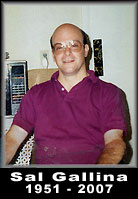 SAL GALLINA - "MUSIC WAS MY LIFE"
SAL GALLINA - "MUSIC WAS MY LIFE"Sal Gallina, born Salvatore Angelo Gallina on June 20, 1951, formally of The Bronx, NY, died peacefully after a long illness on October 4, 2007. He resided at 146 Pine Circle, Bennington, VT 05201.
Sal graduated from the New York High School of Music and Art,
the Manhattan School of Music, Julliard, and the American College
of Forensic Examiners. Sal was an extremely intelligent man who
loved music and was known worldwide for his innovative style
of music.  He
was brilliant, both musically and electronically. One of his
inventions- the Yamaha WX7 MIDI Wind Controller- is used in the
music industry today. It is on display at the Smithsonian Museum
in Washington, D.C. Click
here to learn more about wind controllers. He also loved
the outdoors, exotic and classic cars, anything electronic such
as remote control airplanes and loved to target shoot, especially
with pellet guns.
He
was brilliant, both musically and electronically. One of his
inventions- the Yamaha WX7 MIDI Wind Controller- is used in the
music industry today. It is on display at the Smithsonian Museum
in Washington, D.C. Click
here to learn more about wind controllers. He also loved
the outdoors, exotic and classic cars, anything electronic such
as remote control airplanes and loved to target shoot, especially
with pellet guns.
He leaves behind his grieving family - his parents Justo and Marie (Saia) Gallina of Bennington, VT, his brother Angelo Gallina of Bennington, VT, his sister Fran Artale of Wappingers Falls, NY and his niece Dyanna Artale of Wappingers Falls, NY.
For information on the accomplishments of Sal Gallina, please go to Google or Yahoo and type-in "Sal Gallina".
You can email condolences to: grandmaspugs@hotmail.com
Published in the New York Times 10/19/2007 - 10/20/2007
|
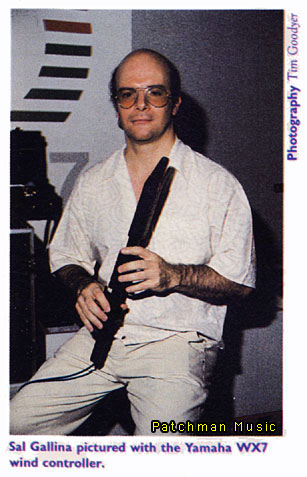 For folks interested in wind controllers,
you might be interested in hearing about a fellow named Sal Gallina.
Sal helped Yamaha back in the mid 1980's with the design of the
first Yamaha wind controller- the Yamaha WX7 which now
hangs in the Smithsonian Institute! The
WX7 won industrial design awards which reflects well on its designers.
Sal was originally a Lyricon player and one can certainly argue
that the Lyricon appears to have had an influence in the design
of the WX7.
For folks interested in wind controllers,
you might be interested in hearing about a fellow named Sal Gallina.
Sal helped Yamaha back in the mid 1980's with the design of the
first Yamaha wind controller- the Yamaha WX7 which now
hangs in the Smithsonian Institute! The
WX7 won industrial design awards which reflects well on its designers.
Sal was originally a Lyricon player and one can certainly argue
that the Lyricon appears to have had an influence in the design
of the WX7.
Sal Gallina remained one of the unsung legends in the music industry. His playing was simply unique. In fact, folks have heard Sal's work without even knowing it on Grammy award winning albums, TV commercials, and top Hollywood movie soundtracks.
For over 30 years Sal pioneered the use of electronic instruments starting with his "Cromulizer" of the 1960s- the first electronic saxophone used by Sonny Rollins- to his key participation in the design and implementation of the revolutionary Yamaha WX7. Sal was noted for his experimentations with heavily modified acoustic saxophones as well. He experimented with all sorts of home-brew electronics with his acoustic saxes to achieve some very bizarre sounds.
Sal Gallina also authored the book "Expressive FM Applications" for Yamaha which was bundled with the WX7. This 104 page book was published in 1987 by Yamaha Music Foundation and Hal Leonard Publications. (ISBN 0-88188-762-5 - $19.95 U.S.) It was available for a time through the Mix Bookshelf catalog but is no longer available. The book included a data cassette containing 32 TX81Z Voices and Performances and 32 DX7II Voices designed by Sal for use with a wind controller. This one of the first products ever designed to support electronic wind controller players subsequently paving the way for others such as Matt Traum (Patchman Music) in this field. Matt went on to develop an entire library of wind controller sounds through the inspiration and work of Sal Gallina.
The "Expressive FM Applications" package originally also included audio tracks on cassette of Sal playing the WX7 and TX81Z. "Expressive FM Applications" also includes details on setting up the WX7, synth patch programming tips, and tips on using various Yamaha gear with a WX7.
Sal later worked in the field of forensic audio.
Sal will be missed.
Thank you, Sal, for your inspiration. Rest In Peace. Your legacy will live on forever.
Matt
Patchman Music
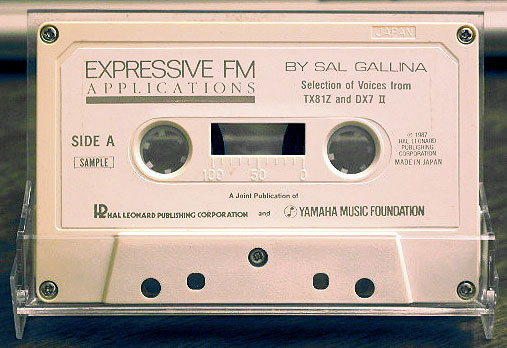 |
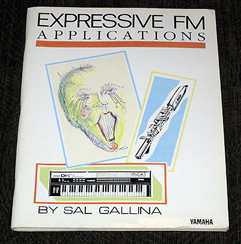 |
|
Music Technology Magazine - December 1987
Click
here to read an excellent interview with Sal Gallina and Nyle
Steiner- the designers of the WX7, EVI1000, and EWI1000 (4 pages).
Aftertouch Magazine - June 1987
"WX7 Sound Sheet" This article discusses the production
of the included sound sheet demo recording of Sal Gallina playing
the WX7. 1 page. See below for the text from this article.
Electronic Musician Magazine - February 1987
Contains a soundsheet recording of Sal Gallina playing a WX7.
Scroll down to hear these recordings.
Electronic Musician Magazine - May 1988
Yamaha WX7 review. 5 pages. Includes a small article on Sal Gallina.
|
Sal Gallina performed and recorded with many artists including...
Mike + the Mechanics - "The Living Years"
Kenny G - "Duotones" - Sal Gallina is credited for playing "Digital wind controller". Also "Violins, French horns and string sounds on 'Don't Make me Wait' played by Sal Gallina and violins on 'Esther' played by Kenny G on the Digital Wind Controller."
Kenny G - "Gravity"
Kid Creole & The Coconuts - "Fresh Fruit in Foreign Places"
Barbara Mason - "I Am Your Woman, She Is Your Wife"
Mo Foster - "Bel Assis"
Roger Sause
John Raymond
Kenny McDougald
Yogi Horton
Tony Gable
|
Thanks to the internet, you can now listen to some of Sal's wonderful wind controller work. Click the links below to download quality MP3 versions of these audio tracks from the WX7 MIDI Wind Controller Demonstration Soundsheet that was used by Yamaha to help promote the WX7 back in 1987. Note that these sounds were created on what many now consider rather outdated FM synths and a basic digital effects processor. You will hear how amazingly realistic and expressive a simple FM synth can sound when played properly by a skilled wind controller player such as Sal Gallina. Also note that on track 10 and track 12 he is using the very cool sustain feature of the WX to play and control two voices in realtime! Amazing!
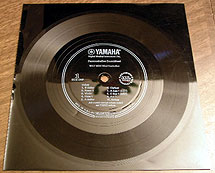
An Introduction To The Attached Evatone Sound Sheet, Featuring Yamaha's New MIDI Wind Controller. By Tom Darter.
This month, the Sound Sheet is a musical introduction to Yamaha's exciting new WX7 MIDI Wind Controller, featuring compositions and performances by Sal Gallina. Sal is a top New York studio musician who has worked with a number of artists on such labels as RCA, CBS, Polygram, Arista, and Capitol.
Side 1 of the Sound Sheet displays the expressive power of the WX7 in a series of solo voice performances. Except where noted, the tone generator used was a Yamaha TX81Z.
1) E. Guitar 2) Power 01 3) Violin 4) Flute 01 5) A. Guitar 6) Clarinet 7) A. Bass 01 (DX7II) 8) E. Bass 01 (DX7II) 9) Sax 01 10) StringsSide 2 of the Sound Sheet features two Sal Gallina compositions, "Rock 1" and "Orchestral 1."
"Rock 1" was created in the studio with tape overdubs. On the first pass, the drum part (generated by an RX5) was recorded, along with the "rhythm guitar" part. Actually, the rhythm guitar part is the WX7 controlling a TX81Z with the "Power 01" patch. On the second pass, Sal added the "bass," which was again the WX7, this time controlling a DX7II with the "E. Bass 02" patch. On the third and final pass, Sal recorded the "lead guitar"-WX7 controlling a TX81Z with the "E. Guitar" patch.
"Orchestral 1" was created in real time, with no overdubs. Sal used various Strings voicings on the TX81Z, with pitch shifts and other effects used to create complex voicings. In addition, he made use of the WX7's "sustain" feature: To begin with, 4 string voices were assigned to MIDI channel 1, and the other 4 were assigned to MIDI channel 2. Sal began by playing on channel 2, and then engaged the "sustain." While the notes on MIDI channel 2 were sustaining, he switched to MIDI channel 1 and played the other 4 string voices in real time.
Both an SPX90 and a REV7 were used throughout the recording- the REV7 for reverb, and the SPX90 for delay, flanging, pitch shift, and other signal processing effects.
For those who are interested in more information on the WX7, Sal Gallina has written a book: Expressive FM Applications. The book is being published by the Yamaha Music Foundation, and will be included with your WX7. It will also be available in the fall at your local book store or Yamaha music dealer. The 86-page book will come complete with a demonstration cassette (which will be new material, not a duplicate of the Sound Sheet in this issue), as well as complete voice data and special effects setups for all the material on the cassette. In all, there will be data for 32 TX81Z voices and 32 DX7II voices.


|
Thanks to Mark Casey for forwarding these cool demos that Sal did with the BitHeadz Unity software sampler. (I don't know what samples were used). From the BitHeadz promo material...
"The Unity banks on this CD are the same ones that Sal used to create the AIFF examples derived from Unity's own stock program Banks. The exception is the Clarinet which Sal has had around the house for years. All of Sal's banks are designed and optimized for a wind controller and will not work from a standard keyboard unless you also have a breath controller attached."
Clarinet.mp3 (108k)
EGtr.mp3 (208k)
EnglishHorn.mp3 (204k)
Flute.mp3 (128K)
NylonGtr.mp3 (144k)
Strings.mp3 (290k)
StringsSolo.mp3 (396k)
|
The Story of Sal
By Stuart Diamond
www.electricdiamond.com, www.stuartdiamond.com
I first heard about Sal Gallina from Bill Bernardi.
Quick background: Bill Bernardi was the inventor of the Lyricon, the first wind synthesizer. Or at least the first woodwind based wind synthesizer and controller versus Nyle Steiner's brass based wind synth. The core premise behind all the wind controllers was to bring the expressivity of wind playing to the emerging world of electronic music performance - to make the endless array of new sounds more musical and human.
The year must have been 1977. I was a young composer living in New York City. My instrument though was the bassoon. Now as much as I love the bassoon, it is not quite the best instrument - at least back then - to rock out on or explore the amplified world of electronic music. Then one day in a music magazine, I uncovered a small ad for a company called Computone, describing the new Lyricon wind synthesizer.
With the realization that there was an instrument that could shape the expressivity of electronic music, I was on the next bus to Boston and down to Cape Cod and the town of Norwell. I found my way to the Computone headquarters, a small one-story warehouse, and met Bill Bernardi.
It was at that time that Bill suggested that I get in touch with Sal Gallina. He described Sal as an odd, genius, tech-wizard prodigy. With no training in engineering or technology, this Sal Gallina had been modifying the inner workings of synthesizers, effects boxes, amps, speakers, and both electronic and acoustic instruments, to amazing effect. Bill must have given me his number.
I returned to New York and waited the few weeks for the Lyricon to arrive. Once I had a working instrument in hand, I was hooked. It was non-stop exploration. Yet, I knew I was meant to meet this Sal Gallina. I called the phone number Bill had given me. I was greeted by a very welcoming voice - a mix of refinement, cool jazz musician, and Italian Bronx. He invited me to his home to see/hear what he was up to.
Sal lived in the basement of his family’s home - a solid middle class, Italian-Jewish area of the Bronx. The house was situated across from the Bronx River Park. I walked up the driveway and entered a side door that led into the basement. Bright lights, linoleum floors, electric parts, wires, soldering irons scattered everywhere - on benches, tables, the floor.
Sal himself. A somewhat diminutive man. Completely bald, even though he was still in his 20s. Round - owl-like tortoise shell glasses and a goatee. Striking, all very much a cool cat from some beatnik movie. Again, he was gracious and hospitable. Who knows what we initially talked about?
But it is not what he said that was important, it was what happened next, when he powered up his gear, picked up his Lyricon and played.
I was simply dumbfounded. Sal smiled enigmatically. Clearly, it was a reaction he was used to getting.
The sound? A vast orchestral string section, massive, multiple parts, drones. Enveloping and overwhelmingly expressive - from tiny pianissimos to a thundering, full-throated Mahleresque soundscape. Well, it didn't sound exactly like a real orchestra. But the sound that it did create was like nothing else I had ever heard from any synthesizer or electronic music setup, especially live and in real-time.
From there Sal went to electric guitars - his version of the Jimi Hendrix Experience. And then onto a kaleidoscope of otherworldly possibilities. And in that instant, my concept of what was sonically possible was changed forever. And I would say that was true for anyone who had ever heard Sal Gallina play.
His instrument? Sal took me on a tour under the hood. He had concocted a synthesizer like no other. On the surface, it looked like a monophonic Oberheim (OB-1) with the keyboard removed. Under the chassis were actually three OB-1s. The audio behemoth was then routed through an array of customized FX devices - often commercial boxes that had been cannibilized and reassembled via Radio Shack parts into one monstrous effect. I went home aware of an entirely new world of what was possible in sound. It certainly impacted what I was to produce from there on in.
Sal and I quickly became friends. I learned his history. Prior to adopting the Lyricon, he developed The Chromulizer - Sal's attempt at turning his acoustic sax into a proto-wind controller for synthesizers. (Later adopted by experimentalist players such as Sonny Rollins and Edgar Winter.)
Sal and I, along with one or two other players became the Lyricon pack - the pioneering wind synth players on the music scene in New York in the 1970s and early 80s. We would get together to jam, played recording sessions, and in one instance were the entire wind section for a Broadway-bound show about Toulouse Lautrec. (The production didn't quite make it all the way to Broadway, but we did the off-Broadway production in the famed Ukrainian National Home in The East Village - a local venue for up and coming shows.)
Acquiring hand-me-down equipment from Sal was always special. He had all sorts of castaway items, synth modules, FX boxes - customized items that were like nothing else on the market. I would go to the Bronx, cash in hand. Entering his colorful, chaotic bazaar, we would consult and transact over his home-made electronic esoterica. However, besides exchanging cash for equipment, a transaction with Sal inevitably included a trip to Arthur Avenue, the Italian restaurant section of the Bronx for a meal to seal the deal. And Sal would always shake his head in dismay, when I ordered a Coke with my veal parmigiana instead a class of wine.
As electronic music turned digital, Sal went with it, becoming the chief consultant for the Yamaha Wind Controller. The prototype is in residence at The Smithsonian Museum in Washington, D.C.
Eventually we lost touch. But I heard rumors. Sal had moved to Florida. He owned liquor stores. He was working with the FBI in audio forensics and had moved to upstate New York to do secret, mysterious work. He knew things we didn't. Made perfect sense, considering it was Sal.
Then sadly, I heard he passed away in 2007.
Sal's importance? I don’t think it was in hi-tech wizardry per se. He was self-taught, and I am sure most geeks could wire rings around him. Sal's contribution was in the realm of imagination - expanding what was sonically possible - to go boldly where no sound-explorer has gone before.
He made me aware - and I am sure countless others - just how vast and powerful the sound from one solo-voiced instrument could be. His sound greatly influenced my work. And to this day, I still stand firmly on one side of the analog-digital divide. Nothing, I have heard to date from digital synths, come close to the vast world of Sal's wind controlled analog sound palette.
My most cherished Sal Gallina memory? Sal and I were walking in Central Park - a bright, glorious Spring day. Sal was complaining that I was walking too fast. I turned to him quipping, "I am like a bicycle. If I go too slow, I fall over." We both laughed. Sal turned and curiously thanked me. "For what?" I asked. "For being a friend." He went on to say something to the effect that growing up he had been such an oddball, no one would play with him. We walked on - a bit slower - bonded like brothers. And I was left to ponder: What was Sal's oddity to some was simply the misperception of genius.
To hear Start Diamond in action. Be sure to search his name on YouTube. Here are a few examples to get you started...
| Be sure to check out the amazing Aerophone Academy Podcast co-hosted by Patchman Music's own Matt Traum and Alistair Parnell (iSax Academy) for in depth discussions and interviews on everything related to wind controllers! |


Check out the INCREDIBLE PATCHMAN TURBO VL Upgrade Chip for the Yamaha VL70-m |
